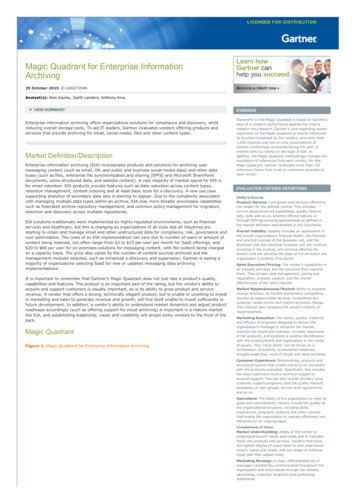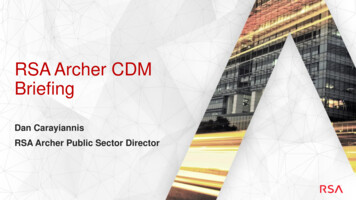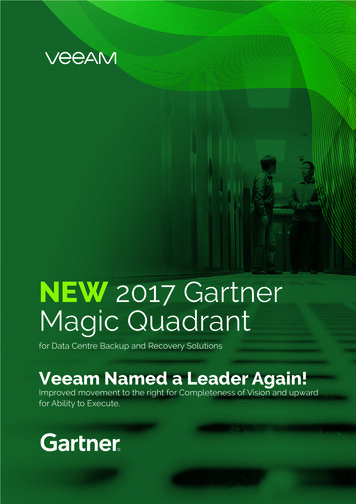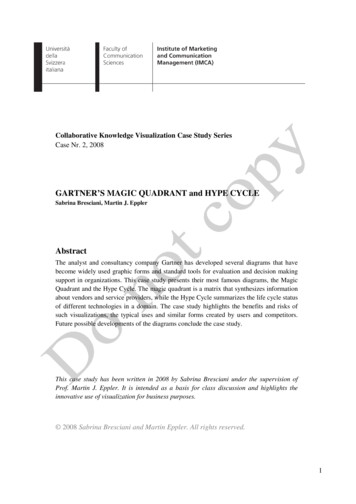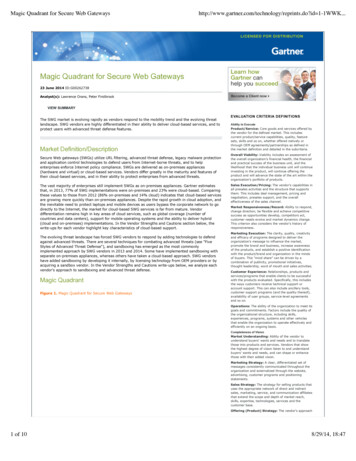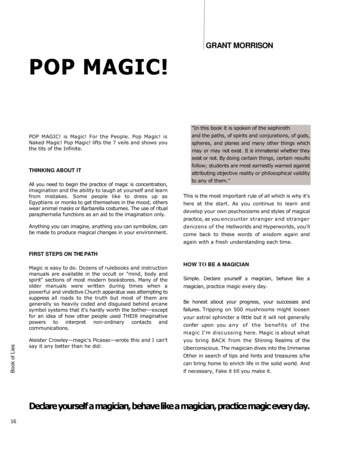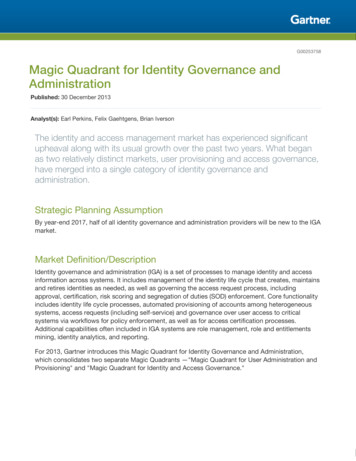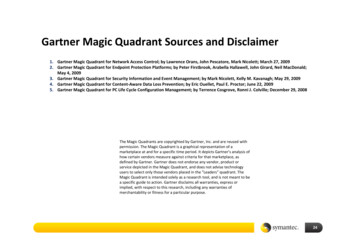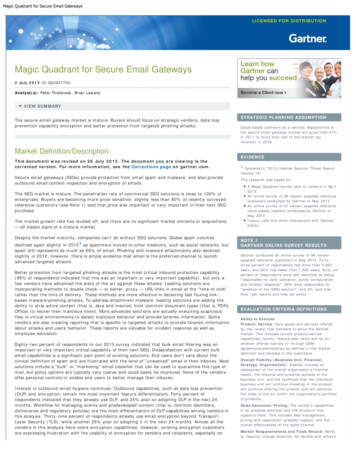
Transcription
Magic Quadrant for Secure Email GatewaysMagic Quadrant for Secure Email Gateways2 July 2013 ID:G00247704Analyst(s): Peter Firstbrook, Brian LowansVIEW SUMMARYThe secure email gateway market is mature. Buyers should focus on strategic vendors, data lossprevention capability encryption and better protection from targeted phishing attacks.Market Definition/DescriptionThis document was revised on 26 July 2013. The document you are viewing is thecorrected version. For more information, see the Corrections page on gartner.com.Secure email gateways (SEGs) provide protection from email spam and malware, and also provideoutbound email content inspection and encryption of emails.The SEG market is mature. The penetration rate of commercial SEG solutions is close to 100% ofenterprises. Buyers are becoming more price-sensitive; slightly less than 80% of recently surveyedreference customers (see Note 1) said that price was important or very important in their next SEGpurchase.The market growth rate has leveled off, and there are no significant market entrants or acquisitions— all classic signs of a mature market.Despite the market maturity, companies can't do without SEG solutions. Global spam volumesdeclined again slightly in 2012 1 as spammers moved to other mediums, such as social networks, butspam still represents as much as 69% of email. Phishing and malware attachments also declinedslightly in 2012; however, there is ample evidence that email is the preferred channel to launchadvanced targeted attacks.Better protection from targeted phishing attacks is the most critical inbound protection capability(98% of respondents indicated that this was an important or very important capability), but only afew vendors have advanced the state of the art against these attacks. Leading solutions areincorporating methods to double check — or better, proxy — URL links in email at the "time of click"rather than the time of delivery. These methods are more effective in detecting fast fluxing linkbased malware/phishing attacks. To address attachment malware, leading solutions are adding theability to strip active content (that is, Java and macros) from common document types (that is, PDFs,Office) to neuter their malicious intent. More advanced solutions are actually executing suspiciousfiles in virtual environments to detect malicious behavior and provide forensic information. Somevendors are also creating reporting that is specific to targeted attacks to provide forensic informationabout attacks and users' behavior. These reports are valuable for incident response as well asemployee education.Eighty-two percent of respondents to our 2013 survey indicated that bulk email filtering was animportant or very important critical capability of their next SEG. Dissatisfaction with current bulkemail capabilities is a significant pain point of existing solutions. End users don't care about theclinical definition of spam and are frustrated with the level of "unwanted" email in their inboxes. Mostsolutions include a "bulk" or "marketing" email classifier that can be used to quarantine this type ofmail, but policy options are typically very coarse and could easily be improved. None of the vendorsoffer personal controls to enable end users to better manage their inboxes.Interest in outbound email hygiene continues. Outbound capabilities, such as data loss prevention(DLP) and encryption, remain the most important feature differentiators. Forty percent ofrespondents indicated that they already use DLP, and 25% plan on adopting DLP in the next 24months. Workflow for managing events and predeveloped content (that is, common identifiers,dictionaries and regulatory policies) are the main differentiators of DLP capabilities among vendors inthis analysis. Thirty-nine percent of respondents already use email encryption beyond TransportLayer Security (TLS), while another 25% plan on adopting it in the next 24 months. Almost all thevendors in this analysis have some encryption capabilities; however, existing encryption customersare expressing frustration with the usability of encryption for senders and recipients, especially onSTRATEGIC PLANNING ASSUMPTIONCloud-based (software as a service) deployments ofthe secure email gateway market will grow from 37%in 2011 to more than half of the market (byrevenue) in 2016.EVIDENCE1 Symantec's "2013 Internet Security Threat Report,Volume 18"This research was based on:A Magic Quadrant survey sent to vendors in April2013An online survey of 96 vendor-supplied referencecustomers conducted by Gartner in May 2013An online survey of 31 vendor-supplied referencevalue-added resellers conducted by Gartner inMay 2013Inquiry calls and other interactions with GartnerclientsNOTE 1GARTNER ONLINE SURVEY RESULTSGartner conducted an online survey of 96 vendorsupplied reference customers in May 2013. Fortythree percent of respondents had more than 5,000seats, and 24% had fewer than 1,000 seats. Sixty-sixpercent of respondents were self-identified as being"responsible for daily operation, policy configurationand incident response"; 28% were responsible for"selection of the SWG solution"; and 6% said thatthey "get reports and help set policy."EVALUATION CRITERIA DEFINITIONSAbility to ExecuteProduct/Service: Core goods and services offeredby the vendor that compete in/serve the definedmarket. This includes current product/servicecapabilities, quality, feature sets, skills and so on,whether offered natively or through OEMagreements/partnerships as defined in the marketdefinition and detailed in the subcriteria.Overall Viability (Business Unit, Financial,Strategy, Organization): Viability includes anassessment of the overall organization's financialhealth, the financial and practical success of thebusiness unit, and the likelihood that the individualbusiness unit will continue investing in the product,will continue offering the product and will advancethe state of the art within the organization's portfolioof products.Sales Execution/Pricing: The vendor's capabilitiesin all presales activities and the structure thatsupports them. This includes deal management,pricing and negotiation, presales support, and theoverall effectiveness of the sales channel.Market Responsiveness and Track Record: Abilityto respond, change direction, be flexible and achieve
Magic Quadrant for Secure Email Gatewaysmobile devices. A key consideration is the encryption solution's level of integration in the SEGmanagement interface.Significant interest in and deployment of virtual solutions and software as a service (SaaS) solutionscontinue. Leading vendors in this market are expanding their offerings vertically into adjacentmarkets (such as mailbox hosting, hosted archiving, e-discovery and continuity services), andhorizontally into secure Web gateway (SWG — see "Magic Quadrant for Secure Web Gateway")solutions linked by common DLP and management. However, buyers' demand for these services fromtheir SEG vendors is mixed, and purchasing decisions rarely coincide.Return to TopMagic QuadrantFigure 1. Magic Quadrant for Secure Email Gatewayscompetitive success as opportunities develop,competitors act, customer needs evolve and marketdynamics change. This criterion also considers thevendor's history of responsiveness.Marketing Execution: The clarity, quality, creativityand efficacy of programs designed to deliver theorganization's message to influence the market,promote the brand and business, increase awarenessof the products, and establish a positive identificationwith the product/brand and organization in the mindsof buyers. This "mind share" can be driven by acombination of publicity, promotional initiatives,thought leadership, word-of-mouth and salesactivities.Customer Experience: Relationships, products andservices/programs that enable clients to besuccessful with the products evaluated. Specifically,this includes the ways customers receive technicalsupport or account support. This can also includeancillary tools, customer support programs (and thequality thereof), availability of user groups, servicelevel agreements and so on.Operations: The ability of the organization to meetits goals and commitments. Factors include thequality of the organizational structure, including skills,experiences, programs, systems and other vehiclesthat enable the organization to operate effectivelyand efficiently on an ongoing basis.Completeness of VisionMarket Understanding: Ability of the vendor tounderstand buyers' wants and needs and to translatethose into products and services. Vendors that showthe highest degree of vision listen and understandbuyers' wants and needs, and can shape or enhancethose with their added vision.Marketing Strategy: A clear, differentiated set ofmessages consistently communicated throughout theorganization and externalized through the website,advertising, customer programs and positioningstatements.Sales Strategy: The strategy for selling productsthat uses the appropriate network of direct andindirect sales, marketing, service, and communicationaffiliates that extend the scope and depth of marketreach, skills, expertise, technologies, services and thecustomer base.Offering (Product) Strategy: The vendor'sapproach to product development and delivery thatemphasizes differentiation, functionality, methodologyand feature sets as they map to current and futurerequirements.Business Model: The soundness and logic of thevendor's underlying business proposition.Source: Gartner (July 2013)Return to TopVendor Strengths and CautionsBarracuda NetworksBarracuda Networks is a private, California-based company that focuses on producing a range ofeconomical, easy-to-use network appliances and SaaS solutions that are aimed primarily at small ormidsize businesses (SMBs), as well as educational and government institutions. Barracuda continuesto grow at above market rates. Barracuda Spam & Virus Firewall appliances are shortlist candidatesfor organizations that are seeking "set and forget" functionality at a reasonable price.StrengthsBarracuda continues to execute well, with respectable growth in an overall declining market.Recent improvements focus on large file attachment handling, configuration backup, better rolebased administration and better encrypted email reporting.An optional cloud-based prefilter, which filters out obvious spam before final filtering, is doneon-premises.Native basic pull-based encryption and DLP capability are included free of charge.Barracuda Control Center can manage multiple boxes, and comes as a free cloud-based offeringor an on-premises appliance.Vertical/Industry Strategy: The vendor's strategyto direct resources, skills and offerings to meet thespecific needs of individual market segments,including vertical markets.Innovation: Direct, related, complementary andsynergistic layouts of resources, expertise or capitalfor investment, consolidation, defensive or preemptive purposes.Geographic Strategy: The vendor's strategy todirect resources, skills and offerings to meet thespecific needs of geographies outside the "home" ornative geography, either directly or through partners,channels and subsidiaries as appropriate for thatgeography and market.
Magic Quadrant for Secure Email GatewaysService prices are per box, rather than per user, making Barracuda a significant price leader.The vendor's email archiving solution has an interface with a consistent look and feel, and itcan also be managed from the same Barracuda Control Center.CautionsBarracuda does not offer any other third-party anti-malware engines, and techniques foradvanced threat detection are missing.The user interface and reporting engine are long overdue for a refresh. The addition ofcustomizable dashboards with hyperlinks to reports, better reuse of policy objects, simplerpolicy workflow and ad hoc reporting would be welcome.DLP is limited to keyword and regular expression filtering. It includes only limited, predefinedDLP dictionaries, and is not object-oriented or group-policy-integrated. Workflow for complianceofficers is limited.The included encryption capability is a good value, but it could be better optimized for mobiledevices.Return to TopCiscoCisco continues to dominate the market for dedicated on-premises solutions for midsize-to-largeorganizations, but has lost some momentum. It offers three deployment options: hardwareappliances, managed appliances and virtual appliances. Cisco enjoys strategic vendor status withmany of its customers and is well-respected in the core network buying centers. It is a goodcandidate for midsize-to-large enterprise customers that are looking for best-of-breed functionality.StrengthsCisco has excellent scalability/reliability, an easy-to-use management interface, deep policycontrol and very granular mail transfer agent (MTA) control capabilities.Its Outbreak Filters option provides unique targeted attack protection by scanning suspiciousURLs at the time of click with Cisco Cloud Web Security. This year, Cisco has madeimprovements in its ability to detect low-volume spam attacks, as well as in assigning IPv6addresses a reputation score.Cisco provides content-aware DLP capabilities with numerous predefined policies, dictionariesand identifiers, as well as a strong compliance officer interface. Integration with RSA EnterpriseManager for DLP integration exists between Cisco's solutions and RSA, The Security Division ofEMC's enterprise DLP.It offers native policy-based email push encryption delivered on box or as a service withmessage recall, read receipt and message expiration; proprietary desktop-to-desktopencryption capabilities; support for iOS, Android and Windows platforms; and large fileattachment handling.Cisco Email Security benefits from Cisco's installed base of network security appliances, andfrom Cisco Cloud Web Security (formerly ScanSafe), by collecting a massive amount of Internettraffic information to spot new malware and spam trends. Cisco's broad array of networksecurity components makes it a strategic vendor for many organizations.CautionsCisco's transition to the general Cisco channel from dedicated IronPort sales representativesand email-specific channel partners will be rough for some users.Cisco's focus on the needs of large enterprises doesn't always scale down well for SMBs. Theuser interface can be confusing and unintuitive for less experienced operators.Cisco spam filtering is highly reliant on reputation, which is less effective for lower-volumesnowshoe spam.Cisco's hosted email offering only has four data centers in the U.S. and Europe so far.While on-premises solutions offer local key management, the hosted solutions only offer keymanagement from a U.S. data center. None of these solutions currently offer compliance withU.S. Federal Information Processing Standard (FIPS) Publication 140-2.Cisco put the PostX encryption appliance in end of sale, which eliminates pull functionality andsupport for Pretty Good Privacy (PGP) and Secure Multipurpose Internet Messaging Extensions(S/MIME); however, it continues to support on-box push encryption. The former PostXfunctionality will continue to be available via Cisco partner totemo.Return to TopClearswiftClearswift has an established presence in the email protection market, primarily in the U.K., Europeand Asia/Pacific. It has also branched out to the SWG market. New ownership and management arepushing the company in the direction of data protection and information governance. Clearswiftoffers hardware appliances, a bare-metal software and VMware/Hyper-V solutions. The combination
Magic Quadrant for Secure Email Gatewaysof SWG and SEG with the provision of basic DLP capabilities across both channels makes Clearswift areasonable shortlist candidate for buyers that are looking for on-premises SEG and SWG solutionsfrom the same vendor.StrengthsThe Web-based management interface provides centralized management, dashboards, andreporting for the Web and email products; a centralized reporting engine; and the contentscanning engine. Nontechnical users will find it easy to use, and it has a lot of context-sensitiverecommendations and help functions.The proprietary Clearswift DLP engine provides fast scanning of more than 150 file formats. Itcontains features to protect against denial-of-service attacks, and provides a selection ofprebuilt patterns for common data types (PCI/personally identifiable information), as well ascommon Boolean and proximity operators.Users can manage their quarantines from any browser, or via an iPhone/iPad interface.Clearswift exploits Commtouch for a portion of its anti-spam capability, and has upgraded tothe most recent engine.The solution includes a "bulk email" category, which is useful for reducing nuisance email.The ImageLogic detection engine for inappropriate and registered images is an extra utilityservice for organizations with this need.On-box encryption with support for S/MIME, PGP and password-protected email encryption, andwith a built-in certificate store, was recently improved with automatic certificate, key extractionand lookup capabilities. The Echoworx partnership provides enhanced encryption capabilities viaa Web portal ("pull") or mailbox ("push").CautionsClearswift is recovering its growth due to a focus on the core email and Web gateway business,and it is improving customer support; however, its market share and mind share are very lowin a rapidly maturing market. The vendor is late to deliver industry-leading features andfunctionality. It does not directly offer a SaaS-based delivery model or vertical products, suchas email archiving. As buyers increasingly look for more strategic integrated vendors, Clearswiftmay have a difficult time standing out in a crowded market.Although the interface is easy to use for nontechnical users, it is limited in detail for moretechnical enterprise users.Advanced encryption provided by Echoworx is not integrated with the management interface. Itlacks any control or visibility of sent messages, and it lacks self-service configuration of theencryption experience.DLP enhancements are needed in the ability to describe sensitive content beyond regularexpressions, along with support for more advanced detection techniques (such as partialdocument matching). Policy management, workflow reporting and event management arerudimentary.Return to TopDellDell acquired SonicWALL and now offers a broad suite of SonicWALL network security solutions,including firewalls, virtual private networks, backup and a range of SEGs. It offers several SEG formfactors, including hardware appliances, software and VMware versions, and hosted versions. Dell alsooffers a subset of SEG functionality that is delivered as SaaS prefilters for its unified threatmanagement (UTM) customers. Dell is a candidate for shortlist inclusion — primarily for existing DellSonicWALL firewall customers.StrengthsDell is one of the largest resellers of Microsoft Exchange solutions, and, with SonicWALL, it isable to sell a full Hosted Email stack, including security.Dell has its own malware research team developing new spam signatures and detectiontechniques, which leverage data from its installed base of appliances. The solution alsoleverages contact databases and communication partners to lower false positives.Dell has the most advanced Domain-based Message Authentication, Reporting and Conformance(DMARC) support and reporting, which enables more precise and useful DomainKeys IdentifiedMail (DKIM) and Sender Policy Framework (SPF) message handling.The management interface is localized in a number of languages and easy to use. It hasmultitenancy support, and reporting is adequate for most organizations' needs.The solution includes basic content-aware DLP functionality with prebuilt dictionaries andnumber identifiers. The policy interface is easy to use with natural-language policy all on asingle page.CautionsIt is difficult for any company to compete in many markets and across company segments —ranging from large enterprises to small offices — while providing market-leading features in
Magic Quadrant for Secure Email Gatewayseach market segment. Dell does not provide any market-leading SEG functionality. Only a smallpercentage of its revenue is email-security-related. Its market share and mind share amongGartner customers are low.Dell's Ability to Execute score was largely impacted by a low score in overall customersatisfaction compared with other vendors in this analysis; however, we do note an improvementin this year's survey. Still, some reference customers commented on the necessity for betterspam and malware detection accuracy.Dell does not offer any advanced malware detection techniques.The management dashboard interface is not customizable.DLP functionality is basic and supports only regular expression matching. Only two prebuiltdictionaries and a handful of number format identifiers are included. It does not include anypredefined policy, and event management is rudimentary.At the time of this analysis, Dell did not have integrated encryption; however, it was embarkingon a beta program for cloud-based encryption that is integrated with the management console.Return to TopFortinetFortinet is a public company with a broad geographical market presence that offers a wide array ofUTM and dedicated appliances for all organization sizes. It also offers an array of anti-spamtechnology in various forms, from client to UTM. This analysis, however, focuses on the dedicatedSEG FortiMail appliances. FortiMail is a shortlist candidate primarily for Fortinet customers that arelooking for a basic SEG solution.StrengthsFortiMail's widget-based management interface is customizable, easy to use and similar to otherFortinet products. FortiManager can manage up to 40 Fortinet devices, and FortiAnalyzerprovides centralized log storage dashboards and reporting.The FortiGuard cloud-based sandboxing service uses behavioral attributes to detect malware byexecuting them within a virtual environment. Suspicious files can be submitted automatically tothe new hosted service for further scanning and detailed status reports.FortiMail provides a number of high-availability and scalability features, such as nativeclustering, load balancing and high-throughput FortiMail hardware appliances.Basic DLP capability and identity-based push and pull encryption are included free of charge inthe standard FortiMail feature set.Appliance-based, rather than user-based, service pricing makes FortiMail very affordable.On-box or off-box policy-based message archiving is fully indexed and available from theFortiMail management interface.CautionsFortinet offers very basic SEG functionality, and is missing more advanced MTA functions forlarger enterprise or more demanding environments. Improvements since our last analysis havefocused on managed security service provider (MSSP) functions, and planned improvements arefocused mostly on better integration with other Fortinet systems.Fortinet only offers its own antivirus scan engine, although it does well in Virus BulletinReactive and Proactive (RAP) tests. It does not have a big or well-known research organization,especially when compared with the Leaders in this Magic Quadrant.The FortiAnalyzer component is required for in-depth, per-domain report and log access acrossmultiple logs in a single interface. However, this component costs extra. Disposition informationto show why email is quarantined is more cryptic than users would like.There is no SaaS deployment option, although it is in the planning stage.DLP functionality is relatively basic; it lacks good policy or compliance workflow, or deepcontent inspection capabilities.Return to TopMcAfeeMcAfee, a subsidiary of Intel, has a broad range of endpoint and network security products. Itconsolidated its two on-premises gateway solutions in v.7.0 (now v.7.7), which is a free versionupgrade that is supported on hardware appliances that are less than three years old. McAfee alsooffers blade server appliances with free additional virtual appliances, integrated hybrid email security(with single management and reporting), and SaaS-based SEG, archiving and disaster recoveryservices. McAfee is a good choice for an integrated hybrid solution, to augment the security of hostedmailboxes, and for existing McAfee customers and prospects looking for an integrated suite ofsecurity products.StrengthsMcAfee's respected threat research team consolidates message, network, Web and file
Magic Quadrant for Secure Email Gatewaysreputation data into its Global Threat Intelligence (GTI) technology. The time-of-click URLredirection for targeted threat protection is very good. We particularly like the "safe preview"capability.McAfee Email Protection's native DLP capability is strong and leverages the abilities of its standalone, enterprise-class, content-aware DLP offering. McAfee provides numerous predefinedpolicies and dictionaries as part of the base product, and it supports self-defined content forpolicy creation.Basic encryption methods (TLS, S/MIME and PGP gateway encryption) are supported, alongwith push (secure envelope) and pull encryption. McAfee Email Protection also supports thesecure transfer of arbitrarily large files via its encrypted email pull capability.The SaaS offering provides a simple, clean, Web-based interface that is very easy to use. It ishosted in seven geographies, and the service can lock message traffic to a specific geographyto avoid processing traffic in foreign legal environments. The time-of-click URL redirectiontargeted threat protection is very good. We particularly like the safe preview option. The timeof-click URL redirection capability is included in the base package, and policy-based pull/pushemail encryption — which includes the DLP capabilities — is an optional add-on. McAfeecustomers can switch between solutions without any additional charge.McAfee Content Security Suite bundles of secure email, Web and DLP in a combined packagethat can be deployed in SaaS, appliances or hybrid for a single price can be very attractive.CautionsMcAfee has not significantly expanded its market share in the enterprise SEG market over thepast three years, and interviews with Gartner clients and reference customers show thatcustomer satisfaction remains lower than average. These issues affect its Ability to Executescore in this analysis.McAfee has some promising sandboxing technology for its on-premises appliances for targetedthreats, but it was not in general availability at the time of this analysis. McAfee does not yetmake use of its cloud Web Gateway technology for time-of-click protection for these appliances.Native DLP compliance workflow is weak, it does not offer a compliance-specific role to restrictview to compliance issues, and it does not allow for log annotation.Several reference customers pointed out the need for reporting improvements.McAfee offers the choice to host encrypted email in only one of the seven data centergeographies. No options are offered for on-premises key management, which is automated byMcAfee. Currently, there is no compliance with key management standards.Return to TopMicrosoftMicrosoft has now consolidated all its anti-spam capabilities into its SaaS-based Exchange OnlineProtection (EOP) product. Microsoft's dominance in the email market makes it a strategic provider ofSEG solutions, and it is making big strides in integrating and improving the service. However, it isnot as polished as the other Leaders.StrengthsMicrosoft is capable of tighter integration of SEG functions with Exchange/Outlook than itscompetitors are. EOP is part of the Office 365 admin center, which provides centralizedmanagement of Microsoft cloud services. EOP management concepts will be familiar toExchange administrators. Exchange Server 2013 and Exchange Online include much improvedDLP capabilities that are tightly integrated with the Outlook client.EOP mirrors email across multiple data centers for redundancy. Microsoft supports in-geographymail processing for two geographies: the U.S. and the European Union.EOP also offers Exchange Hosted Encryption, a solution that is based on Voltage Securitytechnology.Microsoft Active Directory Rights Management Services (AD RMS) has been added as an optionfor end-to-end email encryption services, with Microsoft Windows Azure Active Directory RightsManagement services as the hosted equivalent. Windows Azure Active Directory RightsManagement services offer native, policy-based, on-premises email push encryption withmessage recall, read receipt and message expiration.EOP is included in Exchange Enterprise CAL with Services licenses and in Microsoft EnterpriseCAL Suite. Buyers should check their license entitlements before they consider alternatives.CautionsMicrosoft is not on the leading edge of functionality in this market, and has been slow to offermajor new improvements. We anticipate an acceleration of feature improvements as Microsoftembraces a cloud-first agile development model.Navigating Microsoft licensing can be difficult. EOP is bundled with other services, but it is alsosold separately; however, Gartner clients report difficulty in getting sales to provide EOP-onlyquotes.Microsoft is migrating all customers from the legacy Forefront Online Protection for Exchange
Magic Quadrant for Secure Email Gateways(FOPE) to the new EOP starting in 3Q13, which will cause extra work for existing customers(see "Forefront Online Protection for Exchange [FOPE] Transition Center").Specific advanced targeted threat protection features, such as time-of-click URL protection oractive content stripping, are absent.EOP does not allow end-user-specific blacklists.In-geography-only routing is available only in the U.S. and the EU. While on-premises solutionsoffer local key management, the hosted solutions only offer key management from the U.S.Microsoft AD RMS only support
horizontally into secure Web gateway (SWG — see "Magic Quadrant for Secure Web Gateway") solutions linked by common DLP and management. However, buyers' demand for these services from their SEG vendors is mixed, and purchasing decisions rarely coincide. Return to Top Magic Quadrant Figure 1. Magic Quadrant for Secure Email Gateways
